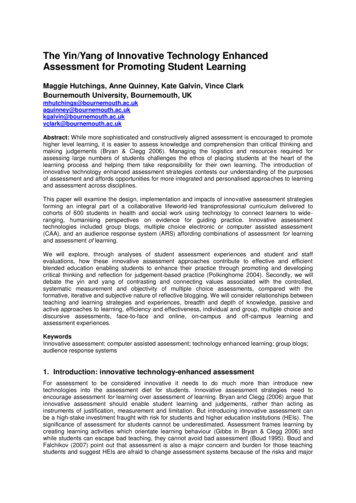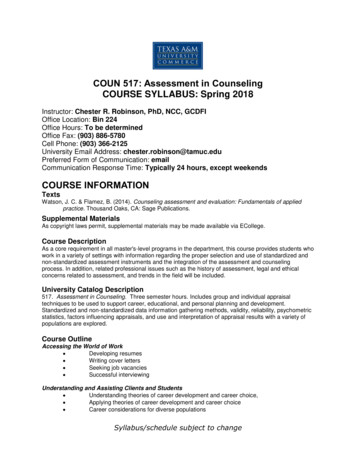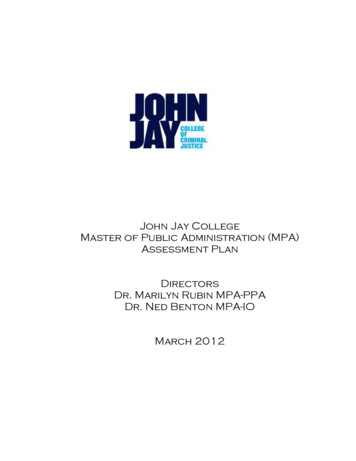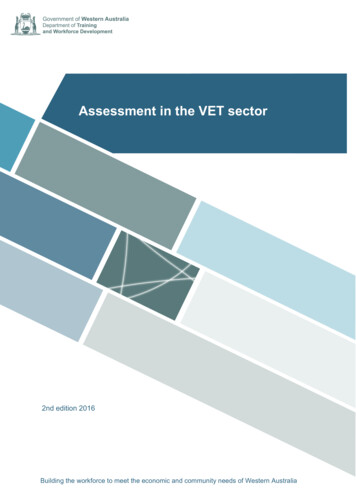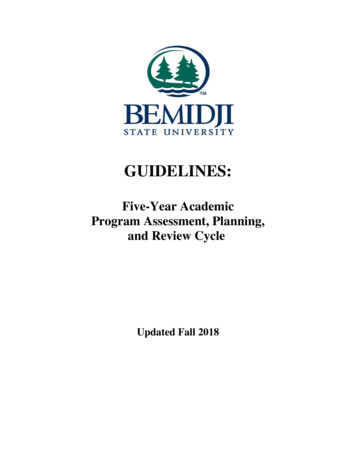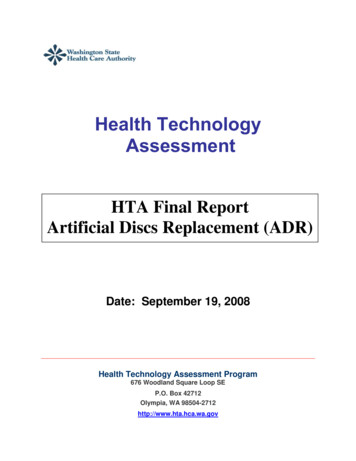
Transcription
Health TechnologyAssessmentHTA Final ReportArtificial Discs Replacement (ADR)Date: September 19, 2008Health Technology Assessment Program676 Woodland Square Loop SEP.O. Box 42712Olympia, WA 98504-2712http://www.hta.hca.wa.gov
Artificial Disc Replacement (ADR)Provided by:Spectrum Research, Inc.Prepared by:Joseph R. Dettori, PhD, MPHAndrea C. Skelly, PhD, MPHRobin E. Hashimoto, PhDErika Ecker, BAAugust 26, 2008This technology assessment report is based on research conducted by a contracted technologyassessment center, with updates as contracted by the Washington State Health Care Authority.This report is an independent assessment of the technology question(s) described based onaccepted methodological principles. The findings and conclusions contained herein are those ofthe investigators and authors who are responsible for the content. These findings andconclusions may not necessarily represent the views of the HCA/Agency and thus, no statementin this report shall be construed as an official position or policy of the HCA/Agency.The information in this assessment is intended to assist health care decision makers, clinicians,patients and policy makers in making sound evidence-based decisions that may improve thequality and cost-effectiveness of health care services. Information in this report is not asubstitute for sound clinical judgment. Those making decisions regarding the provision of healthcare services should consider this report in a manner similar to any other medical reference,integrating the information with all other pertinent information to make decisions within thecontext of individual patient circumstances and resource availability.
WA - Health Technology Assessment – HTAAugust 26, 2008TABLE OF CONTENTSExecutive Summary7ASSESSMENT1. Background1.1 The Condition1.2 The Technology and its Comparator(s)1.3 Clinical Guidelines1.4 Previous Systematic Reviews/Technology Assessments1.5 Medicare and Representative Private Insurer Coverage Policies1.6 Other Significant Evidence12181819282933392. The Evidence2.1 Systematic Literature Review2.2 Methods2.3 Quality of Literature Available2.4 Description of Study Population2.5 Description of Study Outcomes4141415056593. Results3.1 Key Question 1: What is the evidence of efficacy and effectiveness of ADRcompared with comparative therapies (including nonoperative therapy, spinalfusion, other surgery)?3.2 Key Question 2: What is the evidence related to the ADR safety profile(including complications, adverse events, device failure, reoperation)?3.3 Key Question 3: What is the evidence of differential efficacy or safety issuesamongst special populations (including but not limited to the elderly andworkers compensation populations)?3.4 Key Question 4: What are the cost implications and cost effectiveness forADR?6162Summary and Implications96Appendix AAppendix BAppendix DAppendix EAppendix FAppendix GSearch strategiesLevel of evidence determinationAppendix C Inclusion and exclusion criteria for the indexrandomized controlled trials assessing artificial disc replacementDecision tree in assessing results for clinical successData used for ADR meta-analysisA list of adverse events/complications given for the indexrandomized controlled trialsEvidence tables: demographics, study design, andcharacteristics of included studies for ADRArtificial Disc Replacement: Final Evidence Report818687103107112116117121128Page i
WA - Health Technology Assessment – HTAAugust 26, 2008TABLE OF CONTENTS (continued)Appendix HAppendix IAppendix JAppendix KEvidence tables: results of included studies for ADRExcluded studies for ADROverview of outcome measuresClinical and peer reviewers220ReferencesTABLESTable 1Table 2Table 3Table 4Table 5Table 6Table 7Table 8Table 9Table 10Table 11Table 12Table 13Table 14Table 15Table 16Table 17Table 18Table 19164213217219Biomechanical classification of select lumbar total disc arthroplastyprosthesesBiomechanical classification of cervical total disc arthroplastyprosthesesOverview of previous technology assessments of lumbar ADROverview of previous technology assessments of cervical ADROverview of payer technology assessments and policies for L-ADR21Overview of payer technology assessments and policies for C-ADRSummary of inclusion and exclusion criteria for both L-ADR and CADRData from FDA Panel Meeting on Bryan C-ADR used for SpectrumResearch analysisDefinition of the different levels of evidence for articles on therapyComparative clinical studies retained to answer key questions for LADRMethodological quality of RCTs comparing L-ADR with lumbar fusionComparative clinical studies retained to answer key questions for CADRMethodological quality of studies comparing single-level C-ADR withanterior cervical discectomy and fusionOperative and demographic data for the two index randomizedcontrolled trials for L-ADROperative and demographic data for the three FDA randomizedcontrolled trials for C-ADRSensitivity analyses assessing the effect of missing data on the resultsof overall clinical success for the pooled results of the Blumenthal(Charité) and Zigler (Prodisc-L) studiesSensitivity analyses assessing the effect of missing data on the resultsof overall clinical success for the pooled results of the Mummaneni(Prestige ST) and Prodisc-C FDA studiesRisk of all, device related and major adverse events/complications forthe two index randomized controlled trials comparing L-ADR withfusionComplications following L-ADR reported from case-series3742Artificial Disc Replacement: Final Evidence Report24293134474851515354575863738283Page ii
WA - Health Technology Assessment – HTAAugust 26, 2008TABLE OF CONTENTS (continued)Table 20Table 21Table 22Table 23Table 24Table 25Table 26Table 27FIGURESFigure 1Figure 2Figure 3Figure 4Figure 5Figure 6Figure 7Figure 8Figure 9Figure 10Figure 11Figure 12Figure 13Figure 14Figure 15Figure 16Risk of all, device related and major adverse events/complications forthe three FDA randomized controlled trials comparing C-ADR withfusionComplications following C-ADR reported from case-seriesOverview of included partial economic analyses comparing lumbarADR and fusionSummary of mean total costs (2006 USD) from different payerperspectives as reported by Guyer for L-ADRSummary of the number of lumbar ADR procedures performed andtotal charges for Washington State 2005-2007 based on CHARS data(DRG basis)Summary of the number of cervical ADR procedures performed andtotal charges for Washington State 2005-2007 based on CHARS data(DRG basis)Summary of overall strength of evidence for key questions pertainingto L-ADRSummary of overall strength of evidence for key questions pertainingto C-ADRAlgorithm for article selectionFlow chart showing results of literature search for L-ADRFlow chart showing results of literature search for C-ADRClinical success 24 months following L-ADR (intention-to-treatanalysis)Clinical success 24 months following L-ADR (completer-onlyanalysis)Sensitivity analyses assessing the effect of missing data on the resultsof overall clinical success for L-ADRODI 24 months following L-ADR (intention-to-treat analysis)ODI 24 months following L-ADR (completer-only analysis)ODI results over time following L-ADRNeurological success 24 months following L-ADR (intention-to-treatanalysis)Neurological success 24 months following L-ADR (completer-onlyanalysis)Mean change in pain (VAS) from preoperative pain scores at varioustime periods following L-ADRMean flexion-extension before surgery and at follow-up for L-ADRLong term motion at L4-L5 in patients receiving Charité L-ADRcompared with asymptomatic controls after 10 year follow-upMotion profile of L3-4, L4-5, and L5-S1 comparing L-ADR withlumbar fusion in patients who received implants at L4-5Clinical success 24 months following C-ADR (intention-to-treatanalysis)Artificial Disc Replacement: Final Evidence 97071Page iii
WA - Health Technology Assessment – HTAAugust 26, 2008TABLE OF CONTENTS (continued)Figure 17Figure 18Figure 19Figure 20Figure 21Figure 22Figure 23Figure 24Figure 25Figure 26Figure 27Figure 28Figure 29Figure 30Figure 31Figure 32Clinical success 24 months following C-ADR (completer-only analysisexcluding the Bryan FDA interim report)Clinical success 24 months following C-ADR (completer-only analysisincluding the Bryan FDA report)Sensitivity analyses assessing the effect of missing data on the resultsof overall clinical success for C-ADRNDI success 24 months following C-ADR (intention-to-treat analysis)NDI success 24 months following C-ADR (completer-only analysisexcluding the Bryan FDA report)NDI success at 24 months following C-ADR (completer-only analysisincluding the Bryan FDA report)Neurological success 24 months following C-ADR (intention-to-treatanalysis)Neurological success 24 months following C-ADR (completer-onlyanalysis excluding the Bryan FDA report)Neurological success 24 months following C-ADR (completer-onlyanalysis including the Bryan FDA report)Average segmental flexion-extension at the C-ADR instrumented levelcomparing preoperative with postoperative motion at final follow-upAverage segmental flexion-extension at the instrumented levelcomparing C-ADR with ACDFAverage proportion adjacent segment motion (flexion-extension) atfollow-up for C-ADR, ACDF, and asymptomatic controlsDevice failure for L-ADR (reoperation, revision, or removal of theimplant)Device failure for C-ADR (reoperation, revision, or removal of theimplant)Comparison of mean total hospital charges for ProDisc-L ADR andcircumferential fusion based on numbers of levels involvedComparison of mean total costs from hospital perspective (per diemand DRG payment arms) for Charité L-ADR and various fusionproceduresArtificial Disc Replacement: Final Evidence Report71727374747575767679798081838990Page iv
WA - Health Technology Assessment – HTAAugust 26, 2008EXECUTIVE SUMMARYIntroductionLow back pain is a major health problem throughout the world and is the leading cause of painand disability in adults in the United States. As much as 40% of chronic low back pain isthought by some to originate in the intervertebral disc. Chronic low back pain with degenerativedisc disease (DDD) is typically managed conservatively for at least six months before surgery isconsidered.Cervical radiculopathy and myelopathy are neurologic conditions characterized by dysfunctionof the spinal nerve or spinal cord often as a result of degenerative disc disease or spondylosis.The average annual age-adjusted incidence of radiculopathy has been reported as 83 per 100,000,and the prevalence as high as 350 per 100,000 people. While the overall prevalence of cervicalspondylotic myelopathy (CSM) is unknown, it is the most prevalent spinal cord dysfunction inpeople 55 years or older. It is not uncommon for both conditions to be present. It is estimatedthat nearly one fourth of surgical patients being treated for cervical DDD have a combination ofradiculopathy and myelopathy.Surgery is generally indicated when nonoperative conservative treatments fail to relievesymptoms attributed to lumbar DDD or relieve signs of neurological compression or preventprogression of nerve damage in the case of cervical DDD. The current surgical standard of carefor lumbar DDD is lumbar fusion. The goal of this surgery is to remove the disc and fuse thevertebrae, thereby limiting the motion at the painful segment. For cervical DDD resulting inradiculopathy or myelopathy, the current surgical standard is anterior cervical discectomy andspinal fusion. The goal of this procedure is nerve decompression and restoration of spinalalignment and stability. Spinal fusion is thought by some to promote the degeneration of thevertebrae above or below the fusion site (adjacent segment disease); however, manyuncertainties remain regarding the extent to which this occurs.Lumbar artificial disc replacement (L-ADR) is a potential alternative to spinal fusion in patientswith disabling mechanical low back pain. Cervical artificial disc replacement (C-ADR) offers apossible surgical alternative to spinal fusion for patients with radiculopathy and/or myelopathysecondary to DDD. Both L-ADR and C-ADR are intended to preserve motion at the involvedspinal level and therefore decrease stresses on adjacent segment structures and the risk ofadjacent segment disease.In light of the possible benefits of ADR, the potential impact of its use on health care costs anduncertainties regarding the evidence of effectiveness and safety in the short and long term,patients, clinicians, and payers will benefit from a structured, systematic appraisal of thecomparative effectiveness, safety, and economic impact of ADR. Thus, the objective of thistechnology assessment is to critically appraise and analyze research evidence on theefficacy/effectiveness and safety of ADR in the lumbar and cervical spine in patients withdegenerative disc disease and to the extent possible, consider the potential financial impact.To that end, the following key questions developed by the Washington State Health TechnologyAssessment Program will be addressed:Artificial Disc Replacement: Final Evidence ReportPage 1
WA - Health Technology Assessment – HTA August 26, 2008Key Question 1:What is the evidence of efficacy and effectiveness of ADR compared with comparativetherapies (including nonoperative therapy, spinal fusion, other surgery)? Key Question 2:What is the evidence related to the ADR safety profile (including complications, adverseevents, device failure, reoperation)? Key Question 3:What is the evidence of differential efficacy or safety issues amongst special populations(including but not limited to the elderly and workers compensation populations)? Key Question 4:What are the cost implications and cost effectiveness for ADR?Note: In this technology assessment, artificial disc replacement will refer to mechanical totaldisc arthroplasties and not nucleus replacements, annular reconstruction techniques or otherforms of intradiscal spacers.Methods for evaluating comparative effectivenessSpectrum Research, Inc.’s (SRI) method for technology assessment involves formal, structuredsystematic search of the peer-reviewed literature across a number of databases in addition tosearches of pertinent databases related to clinical guidelines and previously performedassessments. Each included study is critically appraised using SRI’s Level of Evidence (LoE)system which evaluates the methodological quality based on study design as well as factor whichmay bias studies. An overall Strength of Evidence (SoE) combines the LoE with consideration ofthe number of studies and consistency of the findings to describe an overall confidence regardingthe stability of estimates as further research is available. Included economic studies were alsoformally appraised based on criteria for quality of economic studies and pertinentepidemiological precepts.Meta-analysis was conducted on the primary outcomes using a random effects model todetermine risk difference (RD) when data from two or more RCTs were available and whenthere was no clinical or statistical heterogeneity among studies. Two analytic perspectives on themeta-analysis for effectiveness are presented: intent-to-treat (ITT) analysis and completer-onlyanalysis.Throughout the process, SRI sought clinical review to assure that the clinical components areaccurately represented and relevant. In addition, peer-review by clinical experts, health servicesresearchers and those with expertise in economic and outcomes evaluation provide an assessmentof the systematic review methodology, analyses and report conclusions.Artificial Disc Replacement: Final Evidence ReportPage 2
WA - Health Technology Assessment – HTAAugust 26, 2008Summary and Implications1. Efficacy/effectiveness of artificial disc replacement (ADR) Findings contained in this technology assessment reflect the use of lumbar or cervicalADR in patients who have failed conservative treatment. For the lumbar spine,conservative treatment for at least six months was required prior to study enrollment. Forthe cervical spine, six weeks of conservative treatment or a progression of neurologicalsigns was an indication for ADR. Neither the type of conservative treatment nor the levelof patient compliance with pre-study conservative treatment was detailed in the publishedstudies used in this technology assessment and therefore, unknown. There is insufficient evidence to draw extensive efficacy/effectiveness conclusionscomparing ADR with a broad range of treatment options. There are no directcomparisons of either lumbar or cervical ADR with continued conservative nonoperativecare. Other than spinal fusion, there are currently no direct comparison studies to assessthe efficacy/effectiveness of either lumbar or cervical ADR compared with other forms ofsurgical intervention such as discectomy without fusion. One study is underway thatincludes three surgical treatment arms for cervical radiculopathy: C-ADR versus anteriorcervical discectomy without fusion versus anterior cervical discectomy with fusion(ACDF). With respect to the comparison of L-ADR and fusion, there is moderate evidence that theefficacy/effectiveness of L-ADR as measured by the composite measure of overall clinicalsuccess, Oswestry Disability Index (ODI) improvement, pain improvement, neurologicalsuccess, SF-36 improvement, and patient satisfaction is comparable with anterior lumbarinterbody fusion or circumferential fusion up to two years following surgery. Thisevidence is based on two moderate quality randomized controlled trials conducted as FDAInvestigational Device Exemption non-inferiority trials. Overall clinical success (acomposite measure considering most or all of the following: ODI improvement, devicefailure, complications, neurological change, SF-36 change and radiographic success) wasachieved in 56% of patients receiving L-ADR and 48% receiving lumbar fusion. Thoughthe results suggest that 24 month outcomes for L-ADR are similar to lumbar fusion, itshould be noted that a non-inferiority trial requires that the reference treatment have anestablished efficacy or that it is in widespread use. For the lumbar spine, the efficacy ofthe comparator treatment, lumbar fusion, for degenerative disc disease remains uncertain,especially when it is compared with nonoperative care. Given what is known aboutlumbar fusion as a comparator and having evidence that only compares L-ADR withlumbar fusion limits the ability to fully answer the efficacy/effectiveness question. There is moderate evidence for the cervical spine that C-ADR is superior to ACDF withrespect to overall clinical success (77% versus 68%) and neurological success (92%versus 86%), and is comparable with ACDF with respect to Neck Disability Index, andpain up to two years following surgery. The evidence is based on two moderate qualityrandomized controlled FDA Investigational Device Exemption non-inferiority trials. Aninterim analysis of approximately 65% of a third RCT was reported in an FDA PanelExecutive Summary. If the results following completion of the trial are similar to theArtificial Disc Replacement: Final Evidence ReportPage 3
WA - Health Technology Assessment – HTAAugust 26, 2008interim results of that same trial, the confidence in the evidence that C-ADR is superior toACDF will increase. There is evidence that segmental motion is maintained or improved up to three years inthe L-ADR patients and up to four years in C-ADR patients compared with preoperativemotion. It is unclear the true extent to which preserving segmental motion by using ADRinstead of fusion influences rates of adjacent segment disease (ASD). Whether ASD is acontinuation of a disease process necessitating fusion or a result of fusion continues to bedisputed. Furthermore, there continues to be debate on whether the presence of ASD isclinically important given that patients with marked radiographic ASD often have nosymptoms.2. Safety of artificial disc replacement (ADR) There is insufficient evidence to draw extensive safety conclusions comparing ADR witha broad range of treatment options. There are no direct comparisons of either lumbar orcervical ADR with continued conservative nonoperative care. Other than spinal fusion,there are currently no direct comparison studies to assess the safety of either lumbar orcervical ADR compared with other forms of surgical intervention such as discectomywithout fusion. There is moderate evidence that L-ADR is as safe as lumbar anterior or circumferentialfusion, and that C-ADR is safer than anterior cervical discectomy and fusion as measuredby the risk of device failure or device/surgical procedure related adverse events orcomplications up to two years following surgery. There is insufficient data at this time to determine the longer term safety of both L-ADRand C-ADR.3. Special or subpopulations There is insufficient evidence to draw conclusions regarding the safety and efficacy of LADR in the few special populations studied (elderly, smokers, athletes). No studies orsub-analyses were found on the use of C-ADR in special or subpopulations.4. Economic implications There are inadequate data from partial economic studies reflecting short time horizons forL-ADR and no economic studies for C-ADR to truly assess the potential costeffectiveness of ADR technology. One report and one previously done HTA suggest thatthe type of fusion may influence complication rates and therefore costs.5. Additional implications The studies primarily reflect outcomes measured up to 24 months and therefore questionsremain regarding the longer term safety and efficacy of L-ADR or C-ADR compared withfusion. This is an important matter, particularly in those receiving C-ADR where theaverage age is near 45 years. Since these are mechanical devices, future failure is apossibility and may influence complication rates and costs in the longer-term.Artificial Disc Replacement: Final Evidence ReportPage 4
WA - Health Technology Assessment – HTAAugust 26, 2008 Findings contained in this report primarily reflect use of ADR at a single level and it maynot be appropriate to extrapolate the results to patients with ADR at multiple levels or forindications other than those evaluated during the FDA trials. As diffusion of these devicesincreases and they are used for additional indications, the safety and efficacy profiles maychange. Studies which met the inclusion criteria for this report encompassed only twobiomechanical types, an unconstrained device and a semiconstrained device. While it wasdeemed reasonable to pool information from trials despite difference in device design, it isprobably appropriate to consider that such differences may influence longer termoutcomes. There are a variety of different biomechanical designs for ADR. There islimited data which directly compare outcomes and complications for different devices inthe short-term or longer term and thus, the influence of different designs is unknown. One study suggests that surgeons and institutions with a high volume of L-ADR caseshave shorter operating time and hospital stay, and lower complication rates which mayhave an economic effect. No effect on clinical outcomes was reported between high andlow volume surgeons or institutions.Artificial Disc Replacement: Final Evidence ReportPage 5
WA - Health Technology Assessment – HTAAugust 26, 2008ASSESSMENTARTIFICIAL DISC REPLACEMENTFinal ScopeRationale for the AssessmentLow back pain is a major health problem throughout the world and leading cause of pain anddisability in adults in the United States.60 As much as 40% of chronic low back pain mayoriginate in the intervertebral disc.143 Chronic low back pain with degenerative disc disease(DDD) is typically managed conservatively for at least six months before surgery is considered.For those patients who do not experience pain relief during that time, the natural history of thedisease is not well documented.Cervical spondylotic myelopathy (CSM) is the most prevalent spinal cord dysfunction in people55 years or older.167 A study of 450 surgical patients being treated for DDD reported that 61%presented with radiculopathy, 16% with myelopathy, and the other 23% had a combination of thetwo133. A study of Nationwide Inpatient Sample (NIS) data collected between 1993 through 2003shows that the number of cervical spinal fusion procedures conducted in the U.S. increased from26 to 50 per 100,000, with symptomatic DDD representing more than four out of every fivecases of cervical DDD cases in 2003.26,167Surgery is generally indicated when nonoperative conservative treatments fail to relievesymptoms attributed to lumbar DDD or relieve signs of neurological compression or preventprogression of nerve damage in the case of cervical DDD. The current surgical standard forlumbar DDD is lumbar fusion. The goal of this surgery is to remove the disc and fuse thevertebrae, thereby limiting the motion at the painful segment. For cervical DDD resulting inradiculopathy or myelopathy, the current surgical standard is anterior cervical discectomy andspinal fusion. The goal of this procedure is nerve decompression and restoration of spinalalignment and stability. Spinal fusion is thought by some to promote the degeneration of thevertebrae above or below the fusion site (adjacent segment disease); however, manyuncertainties remain regarding the extent to which this occurs.Lumbar artificial disc replacement (L-ADR) is a potential alternative to spinal fusion in patientswith disabling mechanical low back pain. Cervical artificial disc replacement (C-ADR) offers apossible surgical alternative to spinal fusion for patients with radiculopathy and/or myelopathysecondary to DDD. Both L-ADR and C-ADR are intended to preserve motion at the involvedspinal level and therefore decrease stresses on adjacent segment structures and the risk ofadjacent segment disease.Although such devices have been used outside of the U.S. for many years and a number ofresearch reports have described positive outcomes, questions remain regarding a number ofimportant issues:Artificial Disc Replacement: Final Evidence ReportPage 6
WA - Health Technology Assessment – HTAAugust 26, 20081. How does the effectiveness of ADR compare with conventional surgical treatment (and ifappropriate, nonsurgical treatment) with respect to patient functional outcomes and painrelief as well as other outcomes including those related to quality of life?2. How does the safety of ADR compare with conventional surgical treatment both over theshort-term and over the long-term (eg, ASD, heterotopic ossification, spontaneousfusion), given that implants are intended to remain intact for the life-time of the patient?3. Might specific patient populations in particular benefit from ADR or have increased risksfor complications from its use?4. Do different biomechanical designs influence comparative safety and efficacy?5. How might the substitution of ADR for fusion in a proportion of patients with theappropriate indications impact health care systems and costs?In light of the possible benefits of ADR, the potential impact of its use on health care costs anduncertainties regarding the evidence of effectiveness and safety in the short term and longer timehorizons, patients, clinicians, and payers will benefit from a structured, systematic appraisal ofthe comparative effectiveness, safety, and economic impact of ADR.ObjectiveTo critically appraise and analyze research evidence on the effectiveness of and complicationsrelated to the use of ADR in the lumbar and cervical spine. If available, formal economicanalyses of ADR will also be critically appraised.Key questionsKey questions were developed by the Washington State Health Technology AssessmentProgram. A conference call with Spectrum Research and representatives of the HTA programprovided clarification of the questions and outcomes. Key Question 1:What is the evidence of efficacy and effectiveness of ADR compared with comparativetherapies (including nonoperative therapy, spinal fusion, other surgery)? Key Question 2:What is the evidence related to the ADR safety profile (including complications, adverseevents, device failure, reoperation)? Key Question 3:What is the evidence of differential efficacy or safety issues amongst special populations(including but not limited to the elderly and workers compensation populations)? Key Question 4:What are the cost implications and cost effectiveness for ADR?Note: In this technology assessment, artificial disc replacement will refer to mechanical totaldisc arthroplasties and not nucleus replacements, annular reconstruction techniques or otherforms of intradiscal spacers.Artificial Disc Replacement: Final Evidence ReportPage 7
WA - Health Technology Assessment – HTAAugust 26, 2008OutcomesThe following outcomes were sought: Efficacy and effectiveness measuresPrimary outcomeso Overall clinical successo Disability indices (Oswestry Disability Index for lumbar, Neck Disability Index forcervical)o Neurological success defined as maintenance or improvement in neurological statuso Pain or pain reductionSecondary outcomeso Quality of life (SF-36)o Return to previous activity or work statuso Rate of adjacent segment disease (ASD)o Range of motion at the instrumented segment Complications and adverse eventso Device failure (reoperation due to revision, reoperation, or removal)o Complications or adverse events reported in included studies and based onregulatory/FDA surveillance Economic measureso Costing dataKey considerations highlighted by clinical experts:1) InterventionsLumbar - Indications for L-ADR include, among other factors, primary lumbar and/orleg pain in the absence of nerve root compression. This group of patients is different thanthose undergoing cervical ADR and results from one group should not be inferre
disc disease (DDD) is typically managed conservatively for at least six months before surgery is considered. Cervical radiculopathy and myelopathy are neurologic conditions characterized by dysfunction of the spinal nerve or spinal cord often as a result of degenerative disc disease or spondylosis.
